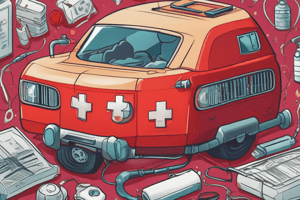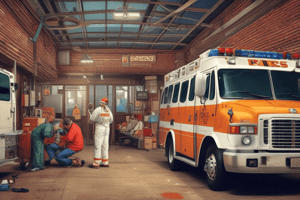Podcast
Questions and Answers
What is the recommended treatment for a 1st degree burn?
What is the recommended treatment for a 1st degree burn?
- Expose the burn to sunlight
- Pop any blisters that form
- Apply ointments, toothpaste, or butter to the burn
- Immerse the burn in cool tap water or apply cold, wet compresses (correct)
What is the most appropriate action if blisters form on a 1st degree burn?
What is the most appropriate action if blisters form on a 1st degree burn?
- Expose the blisters to sunlight
- Let them heal on their own while keeping the area covered (correct)
- Apply topical antibiotics to the blisters
- Pop the blisters to release the fluid
Which over-the-counter medications can help relieve the pain and reduce inflammation of a 1st degree burn?
Which over-the-counter medications can help relieve the pain and reduce inflammation of a 1st degree burn?
- Acetaminophen (Tylenol) or ibuprofen (correct)
- Corticosteroids
- Antihistamines
- Aspirin or naproxen
What is the most appropriate initial action for a 2nd degree burn?
What is the most appropriate initial action for a 2nd degree burn?
What are common symptoms of a 2nd degree burn?
What are common symptoms of a 2nd degree burn?
What are common causes of 2nd degree burns?
What are common causes of 2nd degree burns?
What is the recommended action for burns on the face or body?
What is the recommended action for burns on the face or body?
What is the recommended SPF for sunscreen to protect a healed burn area from the sun?
What is the recommended SPF for sunscreen to protect a healed burn area from the sun?
What does the acronym DCAP-BTLS guide volunteers to look for during the head-to-toe assessment?
What does the acronym DCAP-BTLS guide volunteers to look for during the head-to-toe assessment?
What is the priority during the head-to-toe assessment?
What is the priority during the head-to-toe assessment?
When should permission be sought before conducting the head-to-toe assessment?
When should permission be sought before conducting the head-to-toe assessment?
What should rescuers suspect in unconscious survivors during the head-to-toe assessment?
What should rescuers suspect in unconscious survivors during the head-to-toe assessment?
What should be checked for in extremities during the head-to-toe assessment?
What should be checked for in extremities during the head-to-toe assessment?
What is crucial when encountering closed-head, neck, and spinal injuries during the assessment?
What is crucial when encountering closed-head, neck, and spinal injuries during the assessment?
What are signs of closed-head, neck, and spinal injuries during the assessment?
What are signs of closed-head, neck, and spinal injuries during the assessment?
How should the head be stabilized when encountering closed-head, neck, and spinal injuries?
How should the head be stabilized when encountering closed-head, neck, and spinal injuries?
When does moving patients with suspected injuries require sufficient stabilization?
When does moving patients with suspected injuries require sufficient stabilization?
What is the recommended action for cleaning a burn?
What is the recommended action for cleaning a burn?
What should be avoided when applying first aid to burns?
What should be avoided when applying first aid to burns?
What is the recommended action for head injuries or concussions in the first 24 hours post-injury?
What is the recommended action for head injuries or concussions in the first 24 hours post-injury?
What should be monitored for in a person with head injuries or concussions?
What should be monitored for in a person with head injuries or concussions?
What should be used to create a unique identifier for casualties in a battle roster?
What should be used to create a unique identifier for casualties in a battle roster?
How should the evacuation priority be categorized in a battle roster?
How should the evacuation priority be categorized in a battle roster?
What should be marked in a battle roster for casualties?
What should be marked in a battle roster for casualties?
What is the recommended action for immobilizing the head in case of head injuries or concussions?
What is the recommended action for immobilizing the head in case of head injuries or concussions?
What is a physical symptom of a head injury or concussion?
What is a physical symptom of a head injury or concussion?
What is a cognitive symptom of a head injury or concussion?
What is a cognitive symptom of a head injury or concussion?
What is the recommended action for the first 24 hours after a concussion?
What is the recommended action for the first 24 hours after a concussion?
What should be applied to reduce swelling after a head injury?
What should be applied to reduce swelling after a head injury?
What is the recommended action in case of head injuries or concussions?
What is the recommended action in case of head injuries or concussions?
What should be done to the head in case of head injuries or concussions?
What should be done to the head in case of head injuries or concussions?
What is a symptom of head injuries or concussions related to vision?
What is a symptom of head injuries or concussions related to vision?
What should be checked for in a person with head injuries or concussions?
What should be checked for in a person with head injuries or concussions?
When should CERT volunteers conduct head-to-toe assessments?
When should CERT volunteers conduct head-to-toe assessments?
What should CERT volunteers suspect in all unconscious survivors during the head-to-toe assessment?
What should CERT volunteers suspect in all unconscious survivors during the head-to-toe assessment?
What signs may indicate closed-head, neck, or spinal injuries during the head-to-toe assessment?
What signs may indicate closed-head, neck, or spinal injuries during the head-to-toe assessment?
What is the main objective when encountering suspected injuries to the head or spine?
What is the main objective when encountering suspected injuries to the head or spine?
What is the recommended action for stabilizing the head during a disaster when ideal equipment is not available?
What is the recommended action for stabilizing the head during a disaster when ideal equipment is not available?
What should be checked for in extremities during the head-to-toe assessment?
What should be checked for in extremities during the head-to-toe assessment?
When is it appropriate to move patients with suspected head, neck, or spinal injury?
When is it appropriate to move patients with suspected head, neck, or spinal injury?
What should CERT volunteers always do when conducting a head-to-toe assessment?
What should CERT volunteers always do when conducting a head-to-toe assessment?
What should CERT volunteers look, listen, and feel for during the head-to-toe assessment?
What should CERT volunteers look, listen, and feel for during the head-to-toe assessment?
What details are crucial to record for a casualty during a medical emergency response?
What details are crucial to record for a casualty during a medical emergency response?
What does the DCAP-BTLS acronym help to remember during a rapid assessment?
What does the DCAP-BTLS acronym help to remember during a rapid assessment?
When should the head-to-toe assessment be conducted?
When should the head-to-toe assessment be conducted?
What is the initial step taken by CERT volunteers in a medical emergency?
What is the initial step taken by CERT volunteers in a medical emergency?
What is the aim of the head-to-toe assessment during a medical emergency response?
What is the aim of the head-to-toe assessment during a medical emergency response?
What should first responders use to create a unique identifier for casualties in a battle roster?
What should first responders use to create a unique identifier for casualties in a battle roster?
What are the categories of evacuation priorities in a medical emergency response?
What are the categories of evacuation priorities in a medical emergency response?
What details must be documented for tourniquet application during a medical emergency response?
What details must be documented for tourniquet application during a medical emergency response?
Study Notes
First Aid for Burns
- Remove jewelry and tight clothing around the burn area before cleaning it
- Clean the burn gently with mild soap and water, without breaking blisters
- Avoid applying pain-relief skin sprays on burns
- Apply ointment like petroleum jelly or antibiotic cream to keep the burn moist
- Bandage the burn with gauze or tape, avoiding pressure on the burned skin
First Aid for Head Injuries/Concussions
- Call 911 and immobilize the head in case of head injuries or concussions
- Apply ice to reduce swelling and keep checking cognitive abilities
- For the first 24 hours post-concussion, do not leave the person alone and wake them up periodically
- Monitor for physical symptoms such as blacking out, blurred vision, and nausea, as well as cognitive symptoms like memory problems and mood changes
Battle Roster
- Use the first letter of the casualty's first and last name, and the last four numbers of their social security number to create a unique identifier
- Categorize the evacuation priority as urgent, priority, or routine
- Mark interventions for circulation, airway, breathing, fluid resuscitation, blood products, and medication administration
Medical Emergency Response Procedures
- Casualty identification involves using the first letter of the casualty’s first and last name, and the last four numbers of their social security number.
- Evacuation priorities are categorized as urgent (within 30 minutes), priority (within 24 hours), and routine (within 72 hours).
- Recording the casualty’s gender, date, time of injury, service branch, unit, allergies, mechanism of injury, and vital signs is crucial.
- Tourniquet application details for each limb, including type and time of application, must be documented.
- Evacuation priority, circulation hemorrhage control interventions, airway and breathing interventions, and medication details are recorded for treatment.
- Conducting head-to-toe assessments is essential, focusing on severe bleeding, low body temperature, airway obstruction, and determining the nature of the patient’s injury.
- The head-to-toe assessment aims to determine the extent of injuries, required treatment, and document injuries, emphasizing the use of personal protective equipment (PPE).
- The DCAP-BTLS acronym is used to remember what to look for during a rapid assessment (Deformities, Contusions, Abrasions, Punctures/Penetrations, Burns, Tenderness, Lacerations, and Swelling).
- The assessment should be performed before initiating treatment, unless the patient requires immediate care to prevent serious injury or death.
- First responders should record their name and the last four numbers of their social security number.
- Rapid treatment and assessment are the initial steps taken by CERT volunteers in a medical emergency to provide necessary care and determine the patient’s needs.
- The importance of following the specified procedures, including wearing PPE during assessments, is highlighted for effective medical emergency response.
Studying That Suits You
Use AI to generate personalized quizzes and flashcards to suit your learning preferences.
Description
Test your knowledge of first aid protocols and emergency response procedures with this quiz. Learn how to provide initial care for burns, head injuries/concussions, and create a battle roster for casualties. Master the essential steps to handle medical emergencies effectively.




